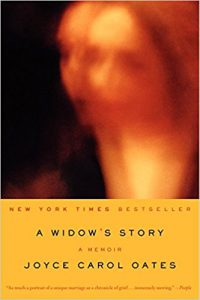A Widow’s Story, by Joyce Carol Oates
A Widow’s Story: A Memoir
Joyce Carol Oates
Ecco
Five stars
Reviewed by Jessica Gribble
I expect that I’ll read A Widow’s Story many times during the rest of my life. Anyone who has grieved for a loved one knows that there are many moments too difficult for words. And yet, part of healing involves sharing the pain of grief with a support system of other people. Joyce Carol Oates, with decades of writing experience, provides the language of grief that can prove so elusive for the rest of us.
It’s no spoiler to say that Oates’s husband dies in the early part of this memoir. We quickly learn that in 2008, Raymond Smith, Joyce’s husband of forty-seven years, spent a week in the hospital with pneumonia and was recovering when he died of a secondary infection. Ray and Joyce have no children and no nearby family, although they have two cats and a close circle of friends. They haven’t spent much time apart since meeting and quickly marrying. Their close relationship is enviable—through the course of the book it becomes evident that they loved each other very much and loved spending time together. But Ray dies and Joyce is left behind to keep on living: something she finds unfair and almost impossible.
In the particularities of this relationship we experience so much of the generalities of grief! Oates is a gifted writer, and she makes some brilliant authorial choices. She uses italics to identify her own thoughts: “I slip my arm around his waist and help him walk and the thought comes to me This is not right. This is terribly wrong for a man’s pride will rarely let him lean on any woman even a wife of forty-seven years.” And she uses italics and quotation marks to identify strong emotions, ideas we should pay particular attention to, and the little details that are noticed and remarked upon in both ordinary life and the haze of grief. “What a widow says, a widow will often regret. Yet a widow must speak. A widow must say something. As a widow must smile, to assure others that she is all right.”
All the big questions are in this book, and they never feel forced or irrelevant. The nature of the relationship between two people who have been split by death. Should it have been stronger? “So much to say in a marriage, so much unsaid. You reason that there will be other times, other occasions. Years!” The possibility for religion to matter in people’s lives. Whether the person who is left behind should go on living. What kind of face to show the outside world when the interior world is destroyed. How to rely on friends and whether it’s possible to explain needing to be left alone. How to re-engage with people and things the dead person loved. Thankfully, there are also stories about Joyce and Ray’s life together, which provide an intimacy that perfectly balances the grandeur of life and death.
Although Joyce Carol Oates considers herself a private person, someone who needs a lot of time to be alone, this memoir is welcoming. We’re invited to share her grief almost without boundaries; she includes the thoughts that people are afraid to admit having, even to themselves. She never flinches from how unhappy it’s possible to be. And yet the grief makes the happy times, the healing moments, all the more exhilarating. The overall emotion of this memoir is of poignancy, not of sorrow. We come away feeling that real life is worthwhile, after all. This is a book that many people will turn to in times of despair to find language for their deepest emotions.
